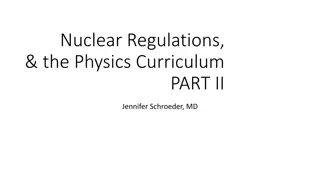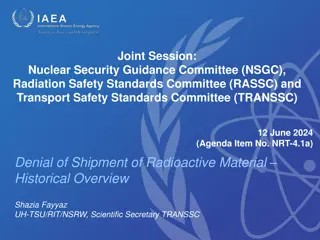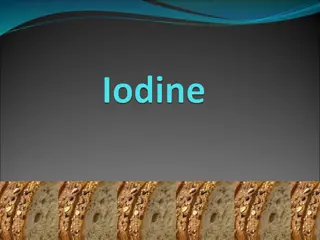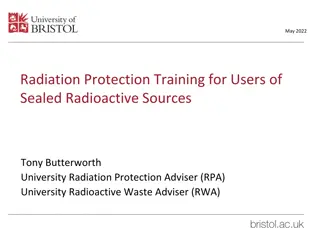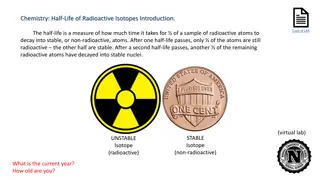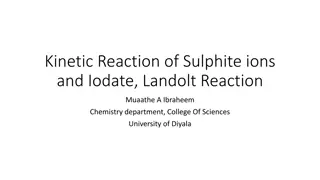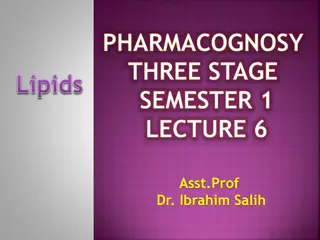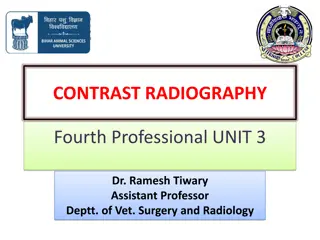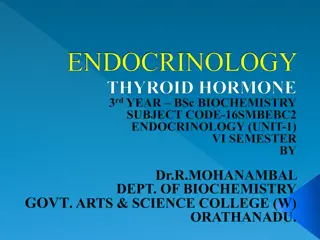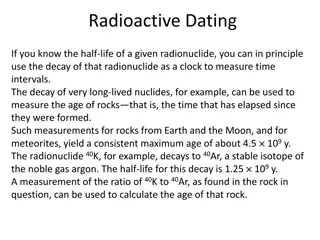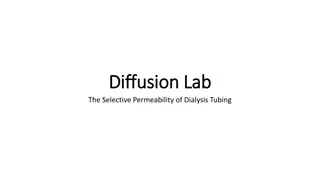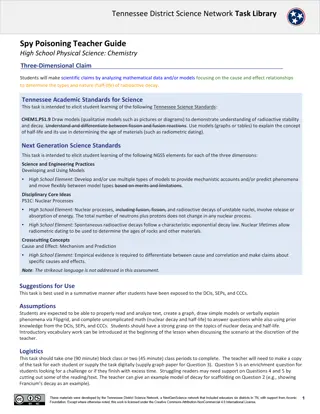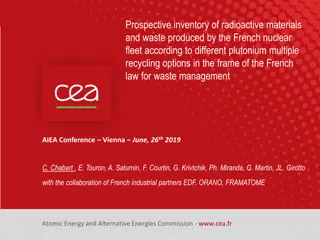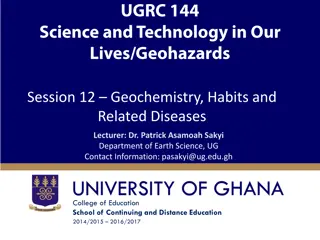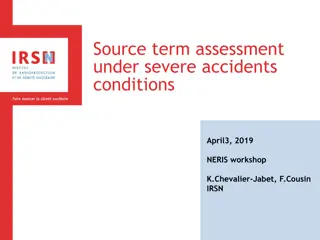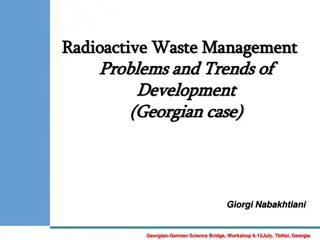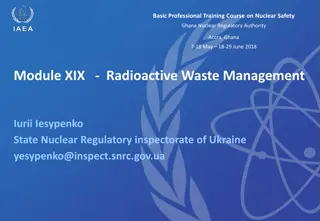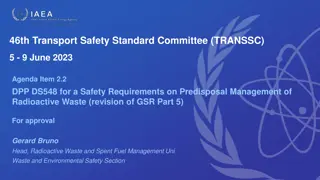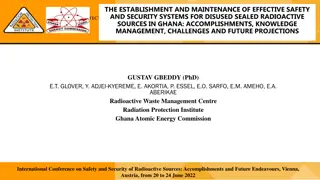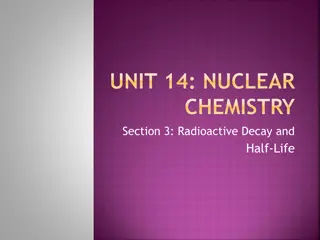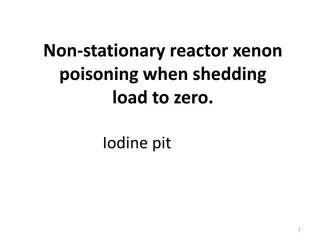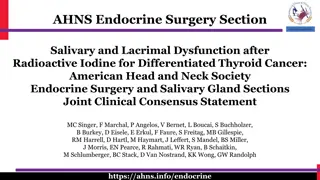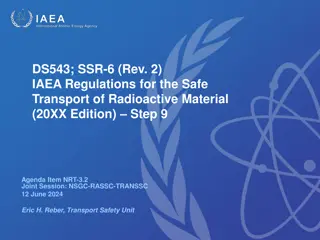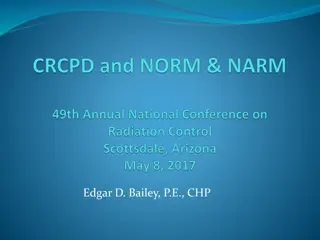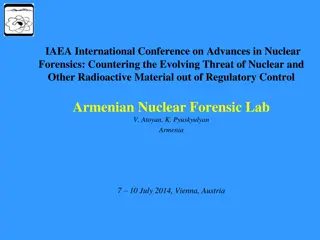Best Practices for Handling Radioactive Spills in Nuclear Medicine Facilities
Understanding the guidelines for dealing with radioactive spills is crucial in nuclear medicine. This comprehensive guide covers major and minor spill scenarios, steps to take in case of a spill, and special considerations for radioactive gas spills. Learn how to ensure safety, prevent contamination
1 views • 34 slides
Understanding Radioactive Decay and Nuclear Radiation
Radioactive decay is the process in which unstable atomic nuclei emit charged particles and energy, transforming into different elements. This process involves the emission of alpha particles, beta particles, and gamma rays. Alpha particles consist of two protons and two neutrons, beta particles are
4 views • 31 slides
Understanding Half-Life in Physics
Half-life is a key concept in physics, particularly in radioactive decay. It is the time taken for the activity of a radioactive source to decrease to half of its original value. This can be determined experimentally through measuring counts per minute and graphing the data. Additionally, half-life
2 views • 11 slides
National Radioactive Waste Management Plan Overview
Briefing the Select Committee on Land Reform, Environment, Mineral Resources, and Energy about the South African Radioactive Waste Management Programme and the legislative background governing radioactive waste management. The presentation outlines the framework, guiding elements, waste management p
4 views • 19 slides
Evolution of Radiopharmacy: A Specialized Field in Pharmacy
The evolution of radiopharmacy as a specialty has progressed rapidly since the 1950s, involving the preparation, dispensing, and clinical investigation of radioactive materials as drugs. Radiopharmacy plays a crucial role in the development and use of radiopharmaceuticals for diagnostic, therapeutic
3 views • 53 slides
Overview of Denial of Shipment of Radioactive Material in NSGC, RASSC, & TRANSSC Joint Session
The Joint Session held by the NSGC, RASSC, and TRANSSC on June 12, 2024, discussed the historical overview and implications of denying shipments of radioactive material. It highlighted the importance of coordination with UN organizations and industry groups in ensuring the safe transport of such mat
1 views • 7 slides
Understanding the Thyroid Gland: Functions and Hormone Synthesis
The thyroid gland is a vital endocrine gland located below the larynx, responsible for producing thyroid hormones essential for regulating metabolism. This gland consists of follicles lined with follicular cells, producing thyroglobulin and thyroid hormones T3 and T4. Iodine plays a crucial role in
0 views • 40 slides
Understanding the Importance of Iodine Supplementation for Pregnancy and Breastfeeding
Iodine is an essential mineral crucial for thyroid function and preventing birth defects like cretinism. It is found in varying amounts in soil, iodized salt, seafood, and certain foods. Iodized salt contains 400 micrograms of iodine per teaspoon. Daily iodine requirements differ based on age and li
0 views • 13 slides
Understanding the Gram Stain Technique in Medical Microbiology Lab
The Gram stain is a crucial technique in bacteriology, dividing bacteria into Gram-positive and Gram-negative groups based on cell wall characteristics. This method involves using crystal violet, iodine, ethanol, and safranin to differentiate between the two types of bacteria. Gram-positive bacteria
0 views • 11 slides
Radiation Protection Training for Users of Sealed Radioactive Sources - May 2022
This document provides radiation protection training tailored for users of sealed radioactive sources, ensuring compliance with legislative requirements and university policies. The training covers topics such as ionising radiation, effects of exposure, monitoring requirements, and more. All trainin
0 views • 81 slides
Exploring Radioactive Decay: A Half-Life Lab Simulation
Explore the concept of radioactive decay through a virtual lab simulation involving strontium-90 (Sr-90) and yttrium-90 (Y-90) isotopes. Witness the decay process over multiple half-lives as unstable atoms transform into stable nuclei. Dive into the intricacies of half-life measurements and the vast
0 views • 10 slides
Kinetic Reaction of Sulphite and Iodate - Landolt Reaction Overview
The kinetic reaction of sulphite ions and iodate in the Landolt reaction is a fascinating chemical process where slow and fast reactions occur sequentially, resulting in a visually striking color change. By monitoring the induction period between the two reactions, one can observe the formation of h
0 views • 9 slides
Fortified Salts Market ppt
Global Fortified Salts Market Breakdown by Application (Food Processing Industry, Hotel & Restaurant, Household, Others) by Type (Iodine Fortified Salt, Iron Fortified Salt, Others) by Sales Channel (Supermarkets\/Hypermarkets, Convenience Stores, On
0 views • 8 slides
Introduction to Lipid Biosynthesis and Fixed Oils in Pharmacognosy Lecture
In this lecture by Asst. Prof. Dr. Ibrahim Salih, the focus is on lipid biosynthesis, specifically the three phases involved: glycerol formation, fatty acid biosynthesis, and triglyceride production. The classification of fixed oils into drying, semi-drying, and non-drying categories based on their
0 views • 13 slides
Understanding Contrast Radiography in Veterinary Surgery and Radiology
Contrast radiography is a crucial technique in veterinary medicine that involves using contrast media to enhance visualization of organs and lesions. Different types of contrast media, positive and negative, are used to alter tissue radio density for better demarcation. Barium and iodine compounds a
0 views • 14 slides
Understanding Thyroid Hormones and Their Role in Metabolism
Thyroid hormones, including triiodothyronine (T3) and thyroxine (T4), are essential for regulating metabolism, growth, development, body temperature, and heart rate. They are tyrosine-based hormones produced by the thyroid gland, requiring iodine for synthesis. T3 affects various physiological proce
2 views • 17 slides
Understanding Radioactive Dating Methods
The process of radioactive dating involves utilizing the decay of radionuclides to measure time intervals, with applications in determining the age of rocks and artifacts. Techniques such as radiocarbon dating, based on isotopes like 14C, enable scientists to determine the age of organic materials b
0 views • 4 slides
Exploring Dialysis Tubing Permeability: Glucose, Starch, and Iodine Experiment
This experiment investigates the permeability of dialysis tubing to glucose, starch, and iodine. By observing color changes and conducting tests, the study demonstrates the selective movement of molecules across the membrane, highlighting the concept of selective permeability in cells.
0 views • 9 slides
Demonstration of Salivary Enzyme Amylase Action in B.Sc. Practical
Salivary enzyme amylase, also known as ptyalin, plays a crucial role in breaking down starch and glycogen into maltose. This practical session in the Zoology department explores the action of salivary enzyme amylase at a temperature of 37°C and pH of 6.6. By conducting experiments with starch, iodi
0 views • 8 slides
Surgical Skin Preparation: Importance and Best Practices
Surgical skin preparation is crucial to reduce microbes and prevent surgical site infections. It involves thorough cleansing to eliminate dirt, oils, and microbes while minimizing the risk of infection. Methods include mechanical friction and using antiseptic solutions like alcohol, iodine, and chlo
0 views • 34 slides
Importance of Algae in Various Industries
Algae have significant economic importance as they serve as primary producers, food sources, fodder for animals, bio-fertilizers, and aids in soil reclamation. They play a crucial role in oxygen production, water pollution reduction, and are utilized in industries such as iodine extraction. Algae ar
0 views • 51 slides
Understanding Plant Nutrition: Testing Leaves for Starch
Learn about testing leaves for starch in plants, the importance of starch as a storage molecule, and the procedure for conducting an iodine test to detect starch levels. Explore the steps involved, the rationale behind each step, and the significance of destarching plants before experimentation.
0 views • 13 slides
Investigating Agent Z's Poisoning: A Case of Radioactive Decay
Agent Z, a double spy, was poisoned with Polonium-210, a heavy, radioactive element. This task challenges students to analyze the cause of his death using concepts of nuclear decay and half-life modeling based on provided data and models. The scenario involves understanding the effects of radioactiv
0 views • 14 slides
Prospective Inventory of Radioactive Materials and Waste Management Study in French Nuclear Fleet
The study conducted by the French Atomic Energy Commission in collaboration with industrial partners like EDF, Orano, and Framatome explores different plutonium recycling options in the French nuclear fleet. It assesses scenarios involving open cycle, mono-recycling, and multiple recycling of pluton
0 views • 16 slides
Understanding Geochemistry and Its Impact on Human Health
This session, led by Dr. Patrick Asamoah Sakyi from the Department of Earth Science at UG, delves into the significance of geological elements in human health, discussing diseases arising from their deficiency or excess intake. Topics include geophagy, fluorine's impact on dental health, iodine defi
0 views • 48 slides
Importance of Iodine Nutrition During Pregnancy
Iodine is essential for thyroid hormone synthesis, crucial for neurological development in utero and early life. Adequate iodine levels prevent adverse effects like decreased IQ, goiter, hypothyroidism, and hyperthyroidism. Mild to moderate iodine deficiency in pregnant women can have adverse outcom
0 views • 21 slides
Understanding Source Term Assessment in Severe Nuclear Accidents
Delve into the complexities of source term assessment under severe accidents conditions, focusing on core degradation, containment pressure buildup, radioactive species release, safety systems, iodine-related phenomenology, and assessing the radioactive source term's impact on the environment. This
0 views • 21 slides
Challenges in Radioactive Waste Management: A Case Study of Georgian-German Science Collaboration
This document delves into the management of radioactive waste, highlighting the problems, trends, and development in the Georgian context. It explores the principles set by the IAEA for waste management, emphasizing the protection of human health, environment, and future generations. The discussion
0 views • 21 slides
Understanding Radioactive Decay and Isotopes in Chemistry
Explore the fascinating world of radioactive decay, isotopes, and nuclear transformations in this educational resource. From reviewing atomic numbers to illustrating alpha and beta decay processes, discover the fundamental principles behind these phenomena with detailed explanations and visuals. Del
0 views • 17 slides
Comprehensive Module on Radioactive Waste Management in Nuclear Safety Training
This module XIX on Radioactive Waste Management explores the generation, classification, treatment, storage, and disposal processes of radioactive waste. It covers the nature and sources of radioactive waste in medical, industrial, and research settings. The module also delves into the regulatory co
0 views • 106 slides
Revision of Safety Requirements for Predisposal Management of Radioactive Waste at 46th TRANSSC
The 46th Transport Safety Standard Committee addresses the revision of GSR Part 5 concerning the predisposal management of radioactive waste. This update aims to harmonize safety requirements with current standards and establish protocols for the safe handling of all types of radioactive waste. The
0 views • 17 slides
Cross-Disciplinary Training Workshop on Radioactive Materials Incident Response
Emphasizing the importance of communication and cooperation between different communities, the Tiger Reef workshop in Kuala Lumpur focused on enhancing capabilities to manage incidents involving radioactive materials. With participants from 21 countries, the workshop aimed to bridge gaps in SOPs, co
0 views • 15 slides
Effective Safety and Security Systems for Disused Sealed Radioactive Sources in Ghana
Ghana has benefited from the peaceful use of sealed radioactive sources in various sectors. The establishment of safety measures, security systems, and knowledge management for disused sealed radioactive sources (DSRS) is crucial. Challenges and future projections in this area are discussed, emphasi
0 views • 15 slides
The Halogens: Properties and Uses of Fluorine, Chlorine, Bromine, Iodine, and Astatine
The halogens are a group of non-metals in the periodic table with seven electrons in their outer shell, making them highly reactive. This article discusses the properties and uses of fluorine, chlorine, bromine, iodine, and astatine. Fluorine is utilized in toothpaste, chlorine is commonly used as a
0 views • 13 slides
Understanding Radioactive Decay and Half-Life in Nuclear Chemistry
Exploring the concept of radioactive decay and half-life in nuclear chemistry, this content covers the types of nuclear radiation, alpha decay of Uranium, and the significance of half-life in determining the decay of radioactive substances such as Carbon-14. An example with Fluorine-18 illustrates t
0 views • 9 slides
Reactor Xenon Poisoning and Iodine Pit Phenomenon
When a non-stationary reactor is shut down or its load is reduced to zero, xenon poisoning occurs due to the disruption of dynamic equilibrium between the increase and decrease of 135Xe. This leads to a temporary increase in 135Xe concentration, followed by a decrease as it decays. The reactivity ma
0 views • 58 slides
Salivary and Lacrimal Dysfunction after Radioactive Iodine Treatment
Radioactive iodine (RAI) is commonly used in treating differentiated thyroid cancer but can lead to salivary and lacrimal dysfunction. This joint clinical consensus statement by the American Head and Neck Society Endocrine Surgery and Salivary Gland Sections highlights the importance of understandin
0 views • 20 slides
International Regulatory Framework for Radioactive Material Transport Safety
SSR-6 (Rev.1) establishes safety requirements for transporting radioactive material to protect people and the environment from ionizing radiation. The framework applies globally across land, water, and air transport modes, involving operations and conditions related to radioactive material movement.
0 views • 24 slides
Regulatory Evolution of Radioactive Materials Licensing
The regulatory landscape surrounding Naturally Occurring and Accelerator-Produced Radioactive Materials (NARM) underwent significant changes in the 20th century. Various entities, including AEC/NRC and states, grappled with the regulation of NARM, leading to a lack of consistency. Initiatives such a
0 views • 17 slides
Challenges and Solutions in Protecting Radioactive Sources in Post-USSR Armenia
The collapse of the USSR presented Armenia with challenges in managing radioactive materials due to limited resources and unclear responsibilities. Incidents of illicit trafficking of radioactive sources have been reported, highlighting the need for robust regulatory controls and forensic capabiliti
0 views • 20 slides
